如需转载,请根据 知识共享署名-非商业性使用-相同方式共享 4.0 国际许可协议 许可,附上本文作者及链接。
本文作者: 执笔成念
作者昵称: zbcn
本文链接: https://1363653611.github.io/zbcn.github.io/2021/01/03/al_10%E5%9B%BE/
图
基本概念
- 线性表和树两类数据结构,线性表中的元素是“一对一”的关系,树中的元素是“一对多”的关系
- 图结构中的元素则是“多对多”的关系
- 图(Graph)是一种复杂的非线性结构,在图结构中,每个元素都可以有零个或多个前驱,也可以有零个或多个后继,也就是说,元素之间的关系是任意的。
无向图
无向图是由顶点和边构成。
有向图
有向图是由顶点和有向边构成。
完全图
如果任意两个顶点之间都存在边叫完全图,有向的边叫有向完全图。如果无重复的边或者顶点到自身的边叫简单图。
图的节点表示
1 | |
2 | static class GraphNode<T> { |
3 | T data; |
4 | List<GraphNode<T>> neighborList; |
5 | boolean visited; |
6 | |
7 | public GraphNode(T data) { |
8 | this.data = data; |
9 | this.neighborList = Lists.newArrayList(); |
10 | this.visited = false; |
11 | } |
12 | |
13 | public boolean equals(GraphNode<T> node) { |
14 | return this.data.equals(node.data); |
15 | } |
16 | |
17 | /** |
18 | * 还原图中所有节点为未访问 |
19 | */ |
20 | public void restoreVisited() { |
21 | restoreVisited(this); |
22 | } |
23 | |
24 | /** |
25 | * 还原node的图所有节点为未访问 |
26 | * @param node |
27 | */ |
28 | private void restoreVisited(GraphNode<T> node) { |
29 | if (node.visited) { |
30 | node.visited = false; |
31 | } |
32 | List<GraphNode<T>> neighbors = node.neighborList; |
33 | for (int i = 0; i < neighbors.size(); i++) { |
34 | restoreVisited(neighbors.get(i)); |
35 | } |
36 | } |
37 | } |
图的深度优先和广度优先搜索
图的深度优先搜索 DFS (Depth First Search)
概述
图的深度优先搜索(Depth First Search),和树的先序遍历比较类似。
思路:假设初始状态是图中所有顶点均未被访问,则从某个顶点v出发,首先访问该顶点,然后依次从它的各个未被访问的邻接点出发深度优先搜索遍历图,直至图中所有和v有路径相通的顶点都被访问到。 若此时尚有其他顶点未被访问到,则另选一个未被访问的顶点作起始点,重复上述过程,直至图中所有顶点都被访问到为止。显然,深度优先搜索是一个递归的过程。
无向图深度优先搜索图解
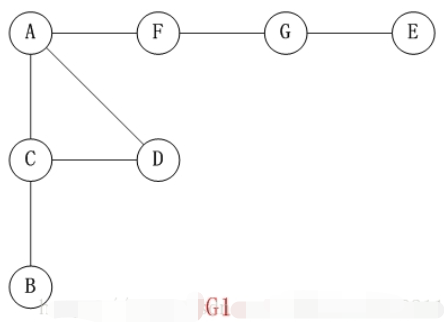
- 对上面的图G1进行深度优先遍历,从顶点A开始。
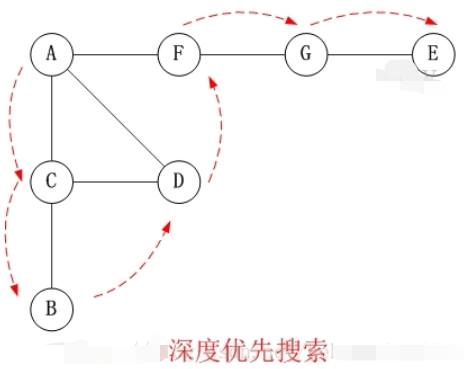
说明
- 第1步:访问A。
- 第2步:访问(A的邻接点)C。在第1步访问A之后,接下来应该访问的是A的邻接点,即”C,D,F”中的一个。但在本文的实现中,顶点ABCDEFG是按照顺序存储,C在”D和F”的前面,因此,先访问C。
- 第3步:访问(C的邻接点)B。在第2步访问C之后,接下来应该访问C的邻接点,即”B和D”中一个(A已经被访问过,就不算在内)。而由于B在D之前,先访问B。
- 第4步:访问(C的邻接点)D。
- 第5步:访问(A的邻接点)F。
- 第6步:访问(F的邻接点)G。
- 第7步:访问(G的邻接点)E。
访问顺序是:A -> C -> B -> D -> F -> G -> E
有向图深度优先搜索图解
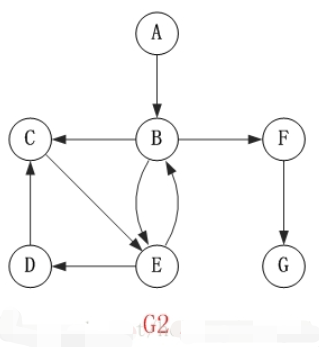
对上面的图G2进行深度优先遍历,从顶点A开始。
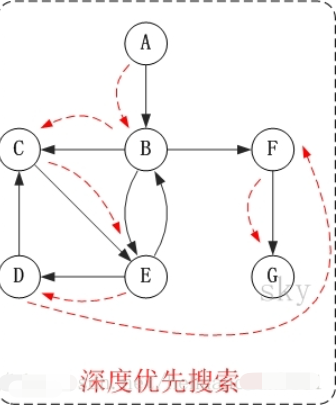
访问顺序是:A -> B -> C -> E -> D -> F -> G
广度优先 BFS (Breadth-First-Search)
介绍
从图中某顶点v出发,在访问了v之后依次访问v的各个未曾访问过的邻接点,然后分别从这些邻接点出发依次访问它们的邻接点,并使得“先被访问的顶点的邻接点先于后被访问的顶点的邻接点被访问,直至图中所有已被访问的顶点的邻接点都被访问到。如果此时图中尚有顶点未被访问,则需要另选一个未曾被访问过的顶点作为新的起始点,重复上述过程,直至图中所有顶点都被访问到为止。换句话说,广度优先搜索遍历图的过程是以v为起点,由近至远。
无向图广度优先搜索图解
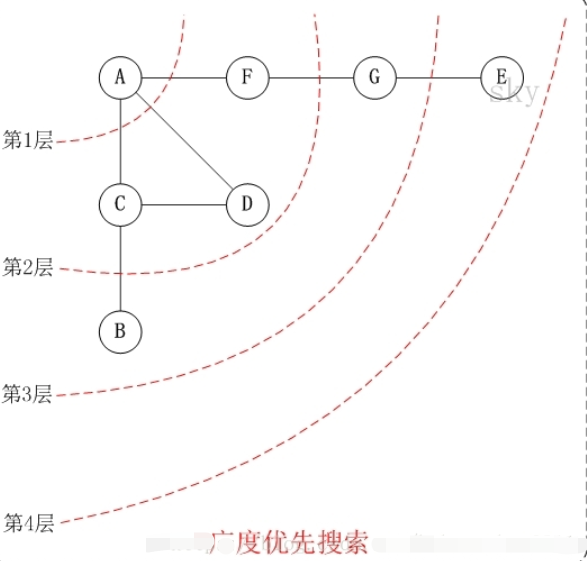
访问顺序是:A -> C -> D -> F -> B -> G -> E
有向图广度优先搜索图解
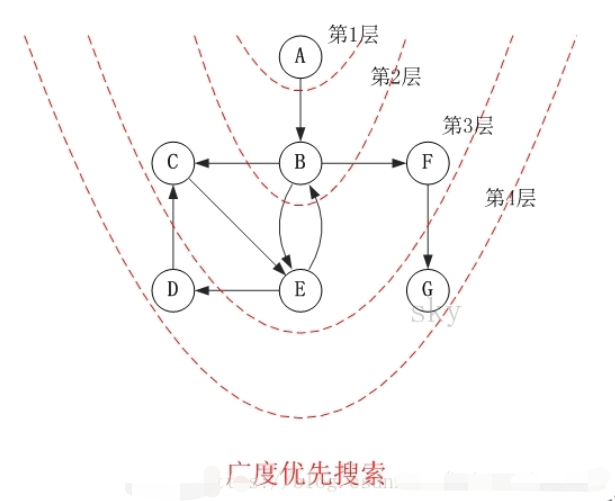
访问顺序是:A -> B -> C -> E -> F -> D -> G
代码实现
1 | /** |
2 | * 图的广度优先搜索和深度优先搜索实现 |
3 | * <br/> |
4 | * |
5 | * @author zbcn8 |
6 | * @since 2021/1/27 11:40 |
7 | */ |
8 | public class GraphSearch<T> { |
9 | |
10 | private static StringBuffer searchPathDFS = new StringBuffer(); |
11 | |
12 | private static StringBuffer searchPathBFS = new StringBuffer(); |
13 | |
14 | |
15 | /** |
16 | * 深度有限搜索法 |
17 | * @param root |
18 | */ |
19 | public void searchDFS(GraphNode<T> root){ |
20 | if (root == null){ |
21 | return; |
22 | } |
23 | if (searchPathDFS.length() > 0){ |
24 | searchPathDFS.append("->"); |
25 | } |
26 | searchPathDFS.append(root.data.toString()); |
27 | root.visited = true; |
28 | for (GraphNode<T> node :root.neighborList){ |
29 | if (!node.visited){ |
30 | searchDFS(node); |
31 | } |
32 | } |
33 | } |
34 | |
35 | /** |
36 | * 广度优先搜索实现,使用队列 |
37 | * @param root |
38 | */ |
39 | public void searchBFS(GraphNode<T> root){ |
40 | Deque<GraphNode<T>> queue = new ArrayDeque<>(); |
41 | if(searchPathBFS.length() > 0){ |
42 | searchPathBFS.append("->"); |
43 | } |
44 | searchPathBFS.append(root.data.toString()); |
45 | root.visited = true; |
46 | // 添加到队尾 |
47 | queue.addLast(root); |
48 | while (!queue.isEmpty()){ |
49 | GraphNode<T> r = queue.pollLast(); |
50 | for (GraphNode<T> node : r.neighborList) { |
51 | if(!node.visited){ |
52 | searchPathBFS.append("->"); |
53 | searchPathBFS.append(node.data.toString()); |
54 | node.visited = true; |
55 | queue.addLast(node); |
56 | } |
57 | } |
58 | } |
59 | } |
60 | |
61 | |
62 | static class GraphNode<T> { |
63 | T data; |
64 | List<GraphNode<T>> neighborList; |
65 | boolean visited; |
66 | |
67 | public GraphNode(T data) { |
68 | this.data = data; |
69 | this.neighborList = Lists.newArrayList(); |
70 | this.visited = false; |
71 | } |
72 | |
73 | public boolean equals(GraphNode<T> node) { |
74 | return this.data.equals(node.data); |
75 | } |
76 | |
77 | /** |
78 | * 还原图中所有节点为未访问 |
79 | */ |
80 | public void restoreVisited() { |
81 | restoreVisited(this); |
82 | } |
83 | |
84 | /** |
85 | * 还原node的图所有节点为未访问 |
86 | * @param node |
87 | */ |
88 | private void restoreVisited(GraphNode<T> node) { |
89 | if (node.visited) { |
90 | node.visited = false; |
91 | } |
92 | List<GraphNode<T>> neighbors = node.neighborList; |
93 | for (int i = 0; i < neighbors.size(); i++) { |
94 | restoreVisited(neighbors.get(i)); |
95 | } |
96 | } |
97 | } |
98 | |
99 | static GraphNode<Integer> node1; |
100 | static GraphNode<Integer> node2; |
101 | static GraphNode<Integer> node3; |
102 | static GraphNode<Integer> node4; |
103 | static GraphNode<Integer> node5; |
104 | static GraphNode<Integer> node6; |
105 | static GraphNode<Integer> node7; |
106 | static GraphNode<Integer> node8; |
107 | static GraphNode<Integer> node9; |
108 | static GraphNode<Integer> node10; |
109 | |
110 | public static void main(String[] args) { |
111 | buildGraph(); |
112 | // GraphSearch<Integer> graphSearch = new GraphSearch<Integer>(); |
113 | // graphSearch.searchDFS(node1); |
114 | // System.out.println(searchPathDFS.toString()); |
115 | |
116 | GraphSearch<Integer> graphSearchBFS = new GraphSearch<Integer>(); |
117 | graphSearchBFS.searchBFS(node1); |
118 | System.out.println(searchPathBFS.toString()); |
119 | } |
120 | |
121 | private static void buildGraph() { |
122 | |
123 | node1 = new GraphNode<Integer>(1); |
124 | node2 = new GraphNode<Integer>(2); |
125 | node3 = new GraphNode<Integer>(3); |
126 | node4 = new GraphNode<Integer>(4); |
127 | node5 = new GraphNode<Integer>(5); |
128 | node6 = new GraphNode<Integer>(6); |
129 | node7 = new GraphNode<Integer>(7); |
130 | node8 = new GraphNode<Integer>(8); |
131 | node9 = new GraphNode<Integer>(9); |
132 | node10 = new GraphNode<Integer>(10); |
133 | |
134 | node1.neighborList.add(node2); |
135 | node1.neighborList.add(node3); |
136 | |
137 | node2.neighborList.add(node4); |
138 | node2.neighborList.add(node5); |
139 | node2.neighborList.add(node6); |
140 | |
141 | node3.neighborList.add(node1); |
142 | node3.neighborList.add(node6); |
143 | node3.neighborList.add(node7); |
144 | node3.neighborList.add(node8); |
145 | |
146 | node4.neighborList.add(node2); |
147 | node4.neighborList.add(node5); |
148 | |
149 | node5.neighborList.add(node2); |
150 | node5.neighborList.add(node4); |
151 | node5.neighborList.add(node6); |
152 | |
153 | node6.neighborList.add(node2); |
154 | node6.neighborList.add(node5); |
155 | node6.neighborList.add(node3); |
156 | node6.neighborList.add(node8); |
157 | node6.neighborList.add(node9); |
158 | node6.neighborList.add(node10); |
159 | |
160 | node7.neighborList.add(node3); |
161 | |
162 | node8.neighborList.add(node3); |
163 | node8.neighborList.add(node6); |
164 | node8.neighborList.add(node9); |
165 | |
166 | node9.neighborList.add(node6); |
167 | node9.neighborList.add(node8); |
168 | node9.neighborList.add(node10); |
169 | |
170 | node10.neighborList.add(node6); |
171 | node10.neighborList.add(node9); |
172 | } |
173 | |
174 | |
175 | } |


